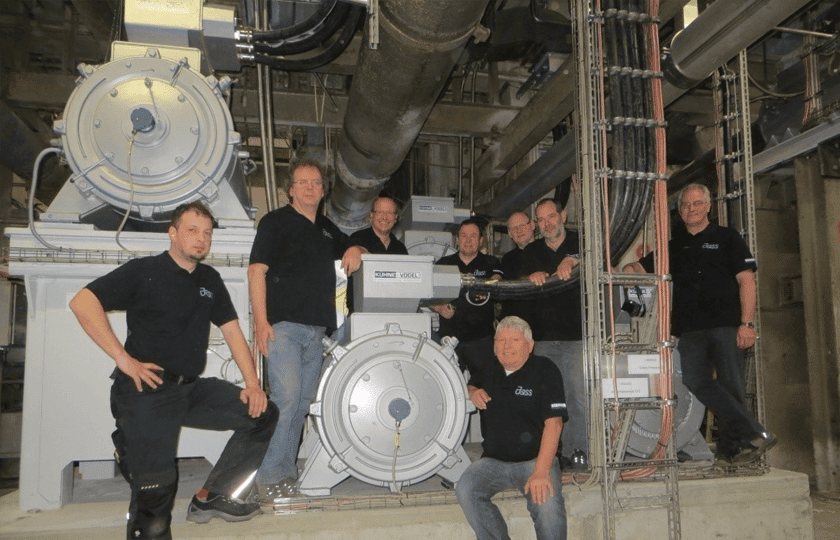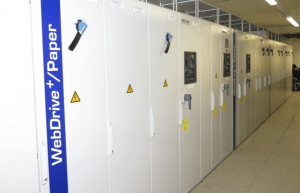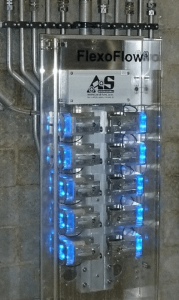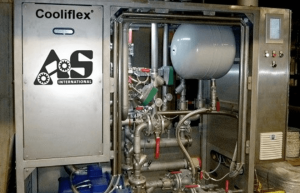
04 Jan 2017 Innovative Direct-Drive Technology in the Field
Upgrades to the PM3 at Papierfabrik Adolf Jass in Fulda
This project fully equipped a paper machine with water-cooled synchronous motors – the first such application in the paper industry. The main requirements for the new sectional drive system for the PM3 at Jass in Fulda were increased production speed, along with significantly improved energy efficiency and machine availability as well as strongly limited spatial conditions on the drive side of the machine. Nine months after its startup, the sectional drive system delivered by Kühne+Vogel Prozessautomatisierung Antriebstechnik GmbH (Kühne+Vogel), in cooperation with AS Drives & Services GmbH (AS), has proven its highest functionality and is showing best results in efficiency and stability.
Starting situation
Even during the first meetings to discuss the planned drive upgrade for the PM3 at Papierfabrik Adolf Jass GmbH & Co. KG, it was clear that the outdated direct-current drive needed to be replaced by modern three-phase technology.
In the process, Papierfabrik Adolf Jass hoped to avoid the use of gear mechanisms altogether, since the PM1 at their new sister plant in Schwarza (built in 2005) had already seen some success with gearless direct drives.
At the time, the PM1 was not completely gearless – it had been delivered with a few major web drives direct-drive technology. So it made sense to adopt the same drive concept for the PM3 in Fulda, but with completely gearless drives wherever possible in contrast to its sister plant.
However, this project once again demonstrated that retrofits are subject to completely different criteria than new construction projects. As a rule, the design of new machines does not necessarily depend on the size of the drive motors, since the necessary open space can usually still be provided; but drive retrofits in existing machines often pose challenges that call for drive motors that are as compact as possible. Philipp Katz, the Plant Manager of the paper factory in Fulda, remembers, “We realized at an early phase in the project that air-cooled synchronous machines like the PM1 would have collided with concrete pillars, cross-beams and pipelines in the wire and press sections of the PM3, and that they would have completely blocked the necessary space for a drive-side pass-through between the machine and the building in the drying groups.” Christoph König, the Head of EMSR, adds, “Since every other conventional drive solution would have taken much more installation space than the planned air-cooled synchronous machines, we had to find innovative implementations to solve this task in an optimal way.”
Ambitious challenges
In addition to requiring the smallest possible installation dimensions for the drive motors, the sectional drive system SDShad the following main specifications:
- increased speed to 1100 m/min
- no intermediate gears
- standardized motor types: IMB3, solid shaft
- motor rated values: 1500–20000 Nm, 250–800 U/min, 690 V
- ambient temperature < 50°C, high humidity level (80%), protection class IP 55
- highest possible efficiency values across the entire operating range, which significantly improves energy efficiency compared to the previous drive
- low maintenance time and cost, highest possible availability, high control accuracy
- robustness and reduced maintenance requirements.
In addition, there was a necessity that the delivered SDS be seamlessly integrated into the existing process control system at Jass. And of course the SDS needed to be as user-friendly and service-friendly as possible in order to smooth the transition from the old to the new technology for the paper manufacturers and service technicians.
Proven partnerships
“The catalog of requirements we created with our potential new customer, Papierfabrik Adolf Jass, was tailor-made for us being a medium-sized company specializing in drive technology,” says Reinhold Kühne, Managing Shareholder at Kühne+Vogel Prozessautomatisierung Antriebstechnik GmbH.
“For more than 25 years, Kühne+Vogel has specialized in the area of automation and drive technology. With AS, we have had a strong partner at our side since 2012 that has been active in the area of mechanical drive technology for just as long. Especially in the area of retrofits and upgrades, our day-to-day business involves creating the perfect concept for our partners, often with a great deal of effort and attention to detail. But that is the most important phase of the project. The groundwork we lay here cannot be corrected later on, and it determines on the the final success of the project. In the design, we need to consider the entire lifecycle of the paper machine drive. Choosing the right motor technology is a key part of creating the concept for the MMD.”
Choosing the drive concept
“The most important factors that influence the choice of drive motors include investment costs and lifecycle costs, control performance with the converter, efficiency at various load levels, motor design and space requirements, robustness and maintenance, cooling type, etc.,” says Dr. Ulrich Strunz, Head of Sales and Development at Kühne+Vogel Prozessautomatisierung Antriebstechnik GmbH. “Because of the benefits of modern torque drives,” he adds, “an increasing number of applications end up choosing gearless direct-drive solutions for the drive concept. In the case of the PM3, too, our concept – based on our HT (High Torque) WebDrive®/Paper drive system – was able to convince the decision-makers at Papierfabrik Adolf Jass, and we were awarded the contract for the SDS retrofitting of the PM3 in June 2015. At the same time, our partner company ASDrives was hired to deliver and assemble all of the associated mechanical drive components, consisting of steel consoles, couplings and protective covers, and to deliver the thermocontrol units for supply of cooling water.” The specialists at Kühne+Vogel were able to solve the space problem with water-cooled synchronous machines. With the exception of the paper guiding rolls and spreader rolls, all of the drives were realized as watercooled motors. 



Paper machine drive created through cooperation
AS was responsible for mechanical integration of the synchronous machines delivered by Kühne+Vogel. The construction of new steel consoles and the arrangement of the new drive components made the machine more accessible and eliminated the old motor-gear units, together with their space-intensive concrete foundations. To do this, AS created measurements of the former situation, transferred all of the data into a 3D model, and used it to create a new drive layout. This created the necessary free space behind the drying groups and prevented collisions with pillars, cross-beams and pipes in the wire and press section.
It even saved additional space compared to the starting situation before retrofitting. Because of the more efficient heat dissipation, the size of water-cooled synchronous machines created an advantage of about 30% over the air-cooled version, depending on the design and performance.
This is also manifested in the weight savings. In the PM3, the weight savings for the motors was 24,000 kg compared to a version with air-cooled synchronous motors, which corresponds to a relative reduction of 28%. This does not even include the corresponding further weight savings due to smaller foundations and pedestals, which additionally has a positive effect.
The MMD, equipped with 27 water-cooled synchronous machines, represents an absolute technical innovation for the paper industry. Christoph König explains, “Right from the start, we were impressed by the concept that Kühne+Vogel had developed. Papierfabrik Jass has always implemented technically innovative concepts in the past as well. So it made perfect sense for us to take this path once we had weighed all the benefits of the WebDrive®/Paper HT technology against the possible risks.” He adds, “So far, the SDS has completely fulfilled all of our expectations. In addition to the compact structure of the motors, the new SDS offers a whole range of additional benefits. In particular, the improved efficiency and the associated energy savings have exceeded our expectations.” Philipp Katz adds, “The already low losses from the synchronous motors can be used to warm process water thanks to energy recovery. That is another building block that helps us comply with ISO 50001, and it will help us save energy costs.”
Energy-efficient cooling
In order to improve energy recovery, the motors are cooled in such a way that – depending on the load point in each case – the process water sent to the secondary cycle maintains a consistently high temperature when the motor cooling water flow remains constant. This is essential in order to practically use the motor heat loss in the process.
Kühne + Vogel’s approach comes with a standard temperature sensor in the motor coil. The actual and expected coil temperatures are constantly calculated and monitored by the WebDrive®/Paper HT controller based on the actual values recorded in the drive converters, using thermal motor models. AS sends the calculated cooling-water target values to two Cooliflex®-brand tempering units via Profibus. Cooliflex® handles the demand-based supply of cooling water to control the temperature in the synchronous machines. The built-in heat exchanger transfers dissipated heat from the synchronous machines to the secondary circuit in order to control the temperature of the process water. 27 intelligent flow regulators made by FlexoFlow®Water are used to further optimize the system. Each FlexoFlow® independently controls the specific water flow for the respective motor. In this way, the required flow rate is kept constant and reliably monitored.


Follow-up contract awarded
For the upcoming retrofitting of the PM4 in Fulda, Adolf Jass is once again trusting in WebDrive®/Paper and the reliable partnership from the PM3 project. Michael Habeck, the Managing Director of Papierfabrik Adolf Jass, confirms, “The innovative sectional drive concept for the PM3 has proven successful in practice. That is why we chose the same solution for upgrading the PM4, and hired the partner companies Kühne+Vogel and AS to implement it.”
